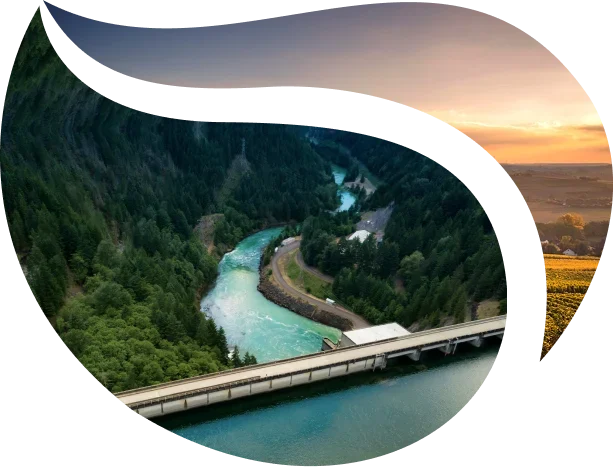 Climate change is a threat to people and the ecosystem services on which we depend.1 Extreme weather events are on the rise.2,3 Flooding, drought, and wildfires are more frequent and more severe.4 Higher temperatures are increasing community health risks.5 The changing climate is causing species dislocation and accelerating the rate of species extinction.6 Global agricultural systems are increasingly stressed.7 These early effects are harbingers of the more severe consequences that science tells us we can expect in the future if we do not act.
Climate change is a threat to people and the ecosystem services on which we depend.1 Extreme weather events are on the rise.2,3 Flooding, drought, and wildfires are more frequent and more severe.4 Higher temperatures are increasing community health risks.5 The changing climate is causing species dislocation and accelerating the rate of species extinction.6 Global agricultural systems are increasingly stressed.7 These early effects are harbingers of the more severe consequences that science tells us we can expect in the future if we do not act.
Even without climate change, standard development patterns and practices are putting our people and our communities at risk.8 Natural systems that protect shorelines are removed to make way for development. Engineered stormwater systems designed to move water rapidly off buildings and pavements disrupt natural hydrology, contribute to water pollution, and weaken or destroy marine ecosystems. “Pave the planet” development replaces natural vegetation with impervious surfaces, leaving even inland communities outside floodplains prone to flooding.9 Development patterns emphasizing car travel isolate communities from recreation opportunities and contribute to unhealthy, sedentary lifestyles. Taken together, these practices have made our communities and people more vulnerable and set the stage for significantly greater loss of property and life in the face of inevitable natural disasters.
The American Society of Landscape Architects’ interdisciplinary Blue Ribbon Panel on Climate Change and Resilience identified the following core areas of focus for promoting healthy, climate-smart, and resilient10 communities.
Natural Systems
Natural Systems Natural systems—or ecosystems—are critical for humans and all forms of life on the planet. Many of the problems we currently face—flooding, urban heat island effect, air and water pollution, coastal erosion, groundwater-related subsidence—are the direct result of either ignoring or trying to engineer our way around natural systems. On the other hand, designing and planning in concert with natural systems promotes resilience, capitalizes on the multiple benefits provided by natural systems, and provides greater long-term return on investment. This natural systems approach should be incorporated in site, community, and regional planning and design, and applied to retrofit and rebuild projects and new development.
Design and planning solutions should also address plant and animal habitat to ensure these living communities remain resilient and productive in the face of climate impacts. Healthy and intact natural systems are inherently resilient. When climate and habitat changes are slow and gradual, plants and animals can relocate through their natural life cycles, e.g., plant seeds spreading naturally and animals moving with food and water sources. However, in the face of rapid climate change and human disturbance, catastrophic loss of species is possible—such as the widespread die-off of temperate tree species in the western states. Design and planning strategies must anticipate and seek to mitigate loss of species through active support.
Community Development
The “smart growth” approach to community planning and design emphasizes compact, walkable, transit-oriented (including active and nonmotorized transportation) development. Smart growth communities are more energy and resource efficient than their urban/suburban sprawl counterparts and provide more opportunities for use of clean energy and distributed generation. When designed in conjunction with natural systems, these communities are also inherently more resilient and climate smart. Smart growth concepts apply at all scales—from individual sites to local communities to broader regional planning.
Vulnerable Communities
Vulnerable communities are those whose location puts them at special risk from the effects of climate change. These include settlements along coastlines and inland waterways that are at risk from flooding and sea-level rise, as well as communities at risk from increased drought, higher temperatures, and wildfires. Further, special attention needs to be paid to underserved and low income communities that have fewer resources and face other barriers to accessing resilience and adaptation solutions. These communities typically lack the community and economic amenities that are promoted in smart growth strategies, and many already suffer adverse health impacts from proximity to industry and degraded environments.
Transportation
Transportation accounts for as much as 30 percent of greenhouse gas emissions. Therefore, smart growth solutions that promote walkability and reduce vehicle use or incentivize nonmotorized and low/zero emission vehicles can have a very significant climate benefit. The Complete Streets approach seeks to equitably include active and nonmotorized transportation choices on all rights-of-way, thereby encouraging people to get out of their cars to the greatest extent possible. By removing vehicle travel lanes, “road diets” improve vehicle and pedestrian safety and, at the same time, enable transportation corridors to become multimodal, improving mobility and access. Vehicle use can be further reduced through disincentives such as reducing the convenience of parking in urban cores and reducing parking requirements for various land uses. Rail, multimodal, and transit-oriented development is needed both in downtown areas and outside downtown areas. As with Complete Streets, a key consideration is ensuring convenience and connectivity that encourages people to consider alternatives to conventional automobile travel.
Agricultural
Conventional—and unsustainable—development patterns of urban and suburban sprawl are causing significant loss of farmland across the United States and around the globe. Changing weather patterns, severe weather events, and competition for water resources are putting additional stress on agricultural systems and directly affecting the global food supply. In addition, various agriculture practices reduce soil fertility, causing soil erosion, and polluting groundwater and surface water resources while releasing carbon dioxide into the air. Clearly, design and planning for climate change and resilience must address current and potential impacts on agriculture and food security as well as soil health. Agricultural systems and food security must also be viewed through the lens of environmental justice; low-income and underserved communities typically suffer from “food deserts”—a lack of convenient or affordable access to healthy food choices.
Read the entire report, along with the working group’s policy recommendations for each focus area here.
Citations:
1 “Ecosystem Services – The benefits produced by ecosystems on which people depend, including, for example, fisheries, drinking water, fertile soils for growing crops, climate regulation, and aesthetic and cultural value.” Source: www.globalchange.gov/climate-change/glossary
2 D.L. Hartmann et al., “Observations: Atmosphere and Surface,” in Climate Change 2013: The Physical Science Basis, Cambridge University Press, Cambridge, United Kingdom, 2013, pp. 208-222.
3 Kossin et al., “Extreme Storms” in Climate Science Special Report: Fourth National Climate Assessment, Volume I, U.S. Global Change Research Program, Washington, D.C., 2017, pp. 257-276.
4 Wehner et al., “Droughts, Floods, and Wildfires” in Climate Science Special Report: Fourth National Cli- mate Assessment, Volume I, U.S. Global Change Research Program, Washington, D.C., 2017, pp. 231-256.
5 Revi et al.,”Urban Areas” in Climate Change 2014: Impacts, Adaptation, and Vulnerability Cambridge University Press, Cambridge, United Kingdom, 2017, pp. 535-612.
6 Oppenheimer et al., “Emergent Risks andKey Vulnerabilities,” in Climate Change 2014: Impacts, Adaptation, and Vulnerability Cambridge University Press, Cambridge, United Kingdom, 2017, pp. 1039-1099.
7 Porter et al., “Food Security and Food Production Systems” in Climate Change 2014: Impacts, Adaptation, and Vulnerability Cambridge University Press, Cambridge, United Kingdom , 2017, pp. 485-533.
8 Revi et al., “Urban Areas,” in Climate Change 2014, p. 520.
9 Revi et al.,“Urban Areas,” in Climate Change 2014, pp.550-563. 9 www.asla.org/climatepolicies.aspx
10 “Resilience is a capability to anticipate, prepare for, respond to, and recover from significant multi-hazard threats with minimum damage to social well-being, the economy, and the environment.” Source: www.globalchange.gov/climate-change/glossary
